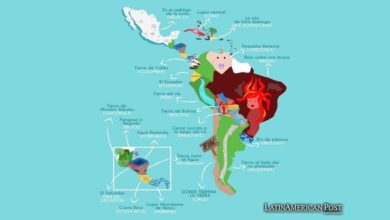Drought in Europe: What Does the Future Hold For The Old Continent?
This is not just any drought, but the worst in almost 500 years. It extends over large regions of Europe, in a historic summer characterized by high temperatures, lack of rain and large fires. Experts warn that this phenomenon could last longer.

Photo: Pixabay
LatinAmerican Post | María Fernanda Camisay
Listen to this article
Leer en español: Sequía en Europa: ¿Qué futuro le espera al Viejo Continente?
Amid extreme heat waves and raging forest fires, nearly half of the European continent is suffering from a lack of rainfall. Dry beds full of empty boats; thousands of dead fish along exhausted riverbeds; withered crops and incredibly low water levels in the main economic arteries, such as the Rhine, the Danube, and the Po, are some of the ravages of an unprecedented drought that has shaken Europe to this day.
After several months of water scarcity, the European Commission predicts that the dry period will continue, forcing urgent measures to be taken. Without a doubt, an alarming scenario that threatens to worsen and become the worst drought in the last 500 years.
Chronicles of a drier Europe
As a consequence of climate change, the sweltering heat waves in Europe arrived much earlier than expected. According to the United Nations (UN), these waves "not only start earlier but are becoming more frequent and severe due to high concentrations of heat-trapping greenhouse gases." And he highlights: "What we are witnessing today is a preview of the future."
With anticipated heat waves, temperatures reached record values in much of the continent, particularly in southwestern and western Europe. Portugal, Spain, Italy, Greece and France were located in the highest part of the thermometer, beating maximum temperatures never seen before. For its part, the United Kingdom exceeded 40 ° C for the first time in its history.
Also read: Gallery: 10 Practical Tips For Coping With A Heat Wave
In addition to causing extreme temperatures and prolonged periods of intense heat, climate change has weakened the air currents that normally bring rain from the Atlantic to Europe. This has caused a pronounced rainfall deficit, according to meteorologist Peter Hoffmann of the Potsdam Institute for Climate Impact Research in Berlin.
In those terms, It is clear to understand that the lack of rainfall during winter and spring has caused a considerable impact on societies and natural ecosystems. Furthermore, the current drought has worsened after successive heat waves that are still latent. Certainly, it is a delicate situation in which "no river in Europe is safe from the water crisis," said the European Drought Observatory.
River water levels are declining worryingly, threatening the aquatic species that live there, as well as commerce, tourism, and industry that rely heavily on water resources and river navigation.
Likewise, numerous lakes and reservoirs have had a significant reduction in their volumes, negatively influencing irrigation, the production of electricity, and the supply of water to homes.
The damage is severe and widespread. In this regard, the report on the Drought in Europe – July 2022, published by the European Commission, details the disturbing state of the vast affected regions, underlining that "France, Germany, Spain, Portugal, Italy and many other countries in Europe will probably have to deal with a drop in crop productivity.”
Among the most affected regions, the Commission stresses that "several areas of Italy, especially the Po basin, are facing intense levels of drought." Similarly, "the circumstances for the Iberian Peninsula are not easy, given that they present the ideal conditions for forest fires and the volumes of water stored in the reservoirs are below the average of recent years."
Surviving on the bare minimum
Finally, the report estimates that this unusual heat and lack of rain will last until the end of September, at least in most European countries.
The outlook is not at all encouraging and for this reason, political leaders have seen the need to go beyond the mere recommendations to save drinking water and accompany them with more severe restrictions such as the prohibition of washing vehicles, filling sinks, and watering private gardens.
At the same time, the drastic fall in the water levels of Europe's main rivers has made it necessary to reduce the load on ships and carry out sand dredging tasks to maintain the fluidity of river traffic, even at a slower rate.
In order to prioritize the reserves available for consumption, the European Commission urged the Member States to advance in the treatment of urban wastewater with the aim of having alternative sources that help safeguard the agricultural sector, without compromising the supply of drinking water.
"In these times of unprecedented temperature peaks, it is our duty to stop wasting water and use that resource in a more efficient way," said the executive body.
More heat, less water: new challenges
Faced with the dramatic scenario that Europeans are experiencing, the UN requested immediate action against drought and global desertification.
“The hard truth is that climate change is upon us. Its impacts will intensify and hit vulnerable countries and communities the hardest, even if we meet the Paris Agreement goals of keeping global warming this century to well below 2°C,” said Inger Andersen, executive director of the United Nations Environment Program (UNEP).
In conclusion, the agency stressed that it is imperative to find locally appropriate nature-based solutions to meet social needs and promote their well-being. As well as, "protect, sustainably manage and restore ecosystems" in order to mitigate and cope with the progress of climate change that is underway.





